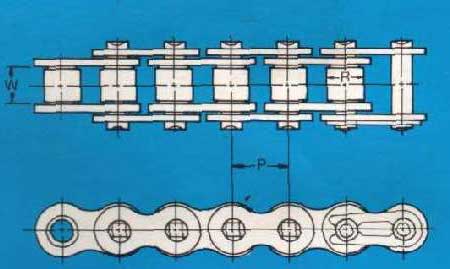Chain size
Chain size is in inches, the three digit number used to describe the chain size is based on the "rule of eights". The first digit is for chain pitch. This is the distance between the pins. The second and third digits combine for the width between the plates and often roller width, with a decimal point inserted between the second and third digits.
| Size | Pitch (P) (inches) | Width Between Link Plates (W) | Roller Diam (R) |
|---|---|---|---|
| 420 | 1/2 (4/8) | 0.252 ~= (2/8) | 0.306 ≠ (2/8) |
| 425 | 1/2 (4/8) | 0.313 ~= (2.5/8) | 0.312 ~= (2.5/8) |
| 428 | 1/2 (4/8) | 0.313 ≠ (2.8/8) | 0.335 ≠ (2.8/8) |
| 428H | 1/2 (4/8) | 0.313 ≠ (2.8/8) | 0.335 ≠ (2.8/8) |
| 520 | 5/8 | 0.252 ~= (2/8) | 0.400 ≠ (2/8) |
| 525 | 5/8 | 0.313 ~= (2.5/8) | 0.400 ≠ (2.5/8) |
| 530 | 5/8 | 0.375 = (3/8) | 0.400 ≠ (3/8) |
| 532 | 5/8 | ||
| 630 | 3/4 (6/8) | 0.375 = (3/8) | 0.469 ≠ (3/8) |
| O-ring Chains | |||
| 428 | 1/2 (4/8) | 0.313 ≠ (2.8/8) | 0.335 ≠ (2.8/8) |
| 520 | 5/8 | 0.252 ~= (2/8) | 0.400 ≠ (2/8) |
| 525 | 5/8 | 0.313 ~= (2.5/8) | 0.400 ≠ (2.5/8) |
| 530 | 5/8 | 0.375 = (3/8) | 0.400 ≠ (3/8) |
| 532 | 5/8 | ||
| 630 | 3/4 (6/8) | 0.375 = (3/8) | 0.469 ≠ (3/8) |
ExceptionsEdit
The 532 chains were originally only used by Suzuki, They are lighter than a 630 but stronger than 530. This allowed high performance bikes such as the Suzuki GSX-R750 to not be robbed of horsepower by a heavy chain. There are a number of chain sizes in use, and chain manufacturers may have slightly different specs for roller diameter, sprocket width, etc. But a 525 chain from one manufacturer will have the same pitch as a 520, 525, 530, or 532 chain from another and run smoothly on any 525 sprocket from any manufacturer.
